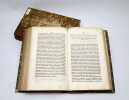6 books for « herschel j f w john... »Edit
"HERSCHEL, J.F.W. (JOHN FREDERICK WILLIAM). - THE ""HERSCHEL CONDITION"" INTRODUCED.
Reference : 46100
(1821)
On the aberration of compound lenses and object-glasses. Read March 22, 1821.
London, W. Bulmer and W. Nicol, 1821. 4to. No wrappers as extracted from ""Philosophical Transactions"" 1821 - Part I. With titlepage to Part I. Pp. 222-267 a. 1 engraved plate. Verso of titlepage with 2 stamps.
First appearance of this importent paper in optical theory in which Herschel described how to free lenses from the aberration for two axis points, one of which is infinitely distant. It is known as Herschel's condition. ""Sir John Herschel gave the condition which must be satisfied in order that a symmetrical optical system, free from spherical aberration for two conjugate axial points, may also be free from spherical aberration for two neighbouring and conjugate points upon the axis of the system" but Herschel's condition applies only to first order aberration, i.e. to aberration depending upon the cube of the inclination of the ray to the axis. Abbe shewed, later, that this condition could be included in a wider result, viz. that the spherical aberration, supposed zero, is stationary for axial variations provided that the incident and emergent rays for two conjugate axial points, associated with modified magnification m, satisfy the relation. (G.C. Stewart)
On the action of crystallized bodies on homogenous light, and on the causes of the derivation from newton's scale in the tints which many of them develope on exposure to a polarized ray. Read december 23, 1819.
London, W. Bulmer and Co., 1820. 4to. No wrappers as extracted from ""Philosophical Transactions"" 1820 - Part I. Pp. 45-100 a. 1 engraved plate.
First printing of one of herschel's importent investigations on polarization and the wave theory of light. He designed a new instrument to project the colored rings onto a screen about three inches behind the analyzer. This method allowed Herschel to examine the details of the tints.
Traité de la lumière
Paris, Mahler & L. Hachette, 1829-1833, in-8, 2 volumes, [8]-508 + [4]-620 pp, 15 pl, Reliure postérieure, dos anciens, ornés de fleurons rocaille, appliqués sur le dos de demi-toile, Première édition française, rare. Bien complet des 15 planches dépliantes gravées sur cuivre (la n° 9 est reliée dans le t. 2). Cet important ouvrage fut traduit par Werhulst et Quetelet qui était le directeur de l'Observatoire de Bruxelles. Ce dernier l'a augmenté d'un supplément rédigé avec la collaboration de plusieurs physiciens dont son compatriote Joseph Plateau qui dernier décrit ici (T.2, pp. 471 à 489) son "phénakistiscope" dans un chapitre intitulé "Sur la persistance des impressions de la rétine". Cet appareil est à l'origine des spectacles animés et du cinématographe. Ex-libris manuscrits et cachet du Dr Alphonse Desmarres (1810-1882), ophtalmologue français. Cachets de l'Institut catholique de Paris. Plats frottés, étiquettes d'inventaire contrecollées sur les premiers plats. Rousseurs. Poggendorff I, 1089. Couverture rigide
Bon 2 volumes, [8]-508 + [4]-620
Catalogue of Nebulae and Clusters of Stars. Received October 16, - Read November 19, 1863.
London, Taylor and Francis, 1864. 4to. No wrappers. In: ""Philosophical Transactions"" Vol. 154, Part I. With titlepage to vol. 154. Pp. 1-137. Stamps to verso of titlepage.
First edition of this importent atlas of Nebulae. The atlas contains 5.079 nebulae and clusters. It was later revised by Johann Dreyer to the widely used ""A New general Catalogue"" or NGG, 1888.
La Caille, Nicolas Louis de, 1713-1762,Henderson, Thomas, 1798-1844,Baily, Francis, 1774-1844,Herschel, John F. W. (John Frederick William), Sir, 1792-1871
Reference : PHO-785
(1847)
A Catalogue of 9766 stars in the Southern hemisphere, for the beginning of the year 1750, from the observations of the abbé de Lacaille, made at the cape of Good Hope in the years 1751 and 1752, reduced... under the immediate superintendence of the late professor Henderson,... and printed... under the direction of the late Francis Baily,... with a preface by Sir J. F. W. Herschel,...
London ,,R.&J.E. Taylor, 1847 , in-8 (220x145) , X-299 p. , relié demi cuir , charnière faible , manque au dos , cachet.
Édition originale ,Nicolas-Louis de Lacaille (1713-1762) est l'un des principaux astronomes français du XVIIIe siècle. Au cours d'une mission dans l'hémisphère sud de 1750 à 1754, il a établi un observatoire au cap de Bonne-Espérance à partir duquel il a observé et mesuré les positions d'environ 10 000 étoiles australes. Près d'un siècle plus tard , l'ensemble des observations de Lacaille est entreprise sous la direction de Francis Baily. Le résultat a été publié en 1847 sous le titre Un catalogue de 9766 étoiles dans l'hémisphère sud.P2-1A
 Write to the booksellers
Write to the booksellers









